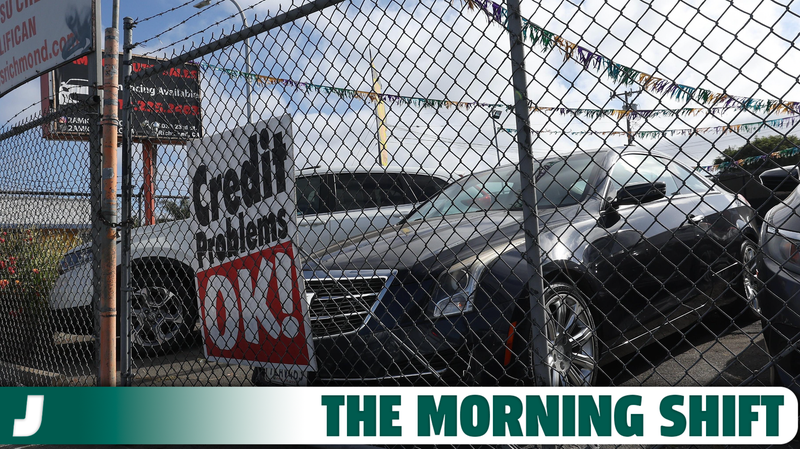The Fed's interest rate cut could boost car sales

On September 18, the Federal Reserve cut its benchmark interest rate target 0.5 percent, and that could have positive ripple effects throughout the automotive industry.
Since July of 2023, the Federal Reserve has left its federal funds rate target at 5.25 to 5.5 percent after rate increases started in mid-March of 2022 from what had been a 0 or 0.25 percent rate target. This was all done in an effort to fight inflation, but it had the side effect of raising interest rates available to folks who were financing cars.
Now, the Fed’s tune is changing, and on Wednesday it announced a new rate target of 4.75 to 5 percent. From Automotive News:
“Many Americans have been holding off on making vehicle purchases in the hopes that prices and interest rates would come down, or that incentives would make a return,” said Jessica Caldwell, Edmunds head of insights, in a statement Sept. 16 ahead of the Fed’s announcement Sept. 18. “A Fed rate cut wouldn’t necessarily drive all those consumers back into showrooms right away, but it would certainly help nudge holdout car buyers back into more of a spending mood, especially coupled with some of the advertising messages that automakers typically push during Black Friday and through the end of the year.”
[...]
“In light of the progress on inflation and the balance of risks, the Committee decided to lower the target range for the federal funds rate,” the Federal Open Market Committee said in a statement. “In considering additional adjustments to the target range for the federal funds rate, the Committee will carefully assess incoming data, the evolving outlook, and the balance of risks.”
The vote on the 0.5-point rate cut was nearly unanimous. However, Federal Reserve Governor Michelle Bowman voted against it, feeling the Fed should only have cut the rate by 0.25 points.
In July, the Fed’s inflation metric remained at 2.5 percent, above the 2 percent mark the central bank seeks but better than the 3.3 percent in July 2023 and a significant improvement from 6.6 percent in July 2022.
A Cox Automotive Dealer Sentiment Index survey of 536 franchised dealers from July 23 to Aug. 7 found interest rates were the No. 1 factor dealerships saw as hindering their business, with 67 percent of dealers calling them a challenge. Third-quarter polling a year earlier also saw 65 percent of franchised dealers calling interest rates a problem.
“A reduction in interest rates by the Federal Reserve, something that has been signaled previously, will likely be welcome by consumers who are in the market for a new vehicle, and by dealers who finance their vehicle inventory,” said Satyan Merchant, senior vice president and automotive and mortgage business leader at TransUnion, in a statement Sept. 12. “However, the short-term impact may be muted, and it may take until later in 2024 or even 2025 to see interest rates as well as vehicle prices come down enough for consumer demand to materially increase.
Last month, Edmunds conducted a survey of folks who bought a car in the past and planned to buy one again in the next 12 months. It found that 62 percent of them were putting off the purchase because interest rates were too high. The survey also showed that 64 percent of them said they’d change their timing if the Fed cut rates.
The most rate-conscious people were electric vehicle buyers and consumers under 45 years old. It makes sense. We don’t have any money.
Seventy-two percent of vehicle shoppers younger than 45 said a Fed rate cut would change their vehicle purchase timetable, though so did 57 percent of the older borrowers. Seventy-four percent of the consumers considering an EV next said a Fed cut would impact the timing of their vehicle purchases, while 57 percent of the other shoppers called a cut a factor.
Here’s how prices and payments have evolved over the past few years:
In February 2022, the last full month before the Fed’s rate increases, the average new-vehicle buyer saw a $656 monthly payment and a 4.4 percent interest rate on a $39,772 70-month loan, which meant $5,395 in interest over the life of the loan, according to Edmunds. The average used-vehicle buyer received a $544 monthly payment at 7.8 percent interest on a $31,138 loan over 70.5 months, which meant $7,776 interest.
In August 2023, the first full month of the Fed’s 5.25 to 5.5 percent rate target, the average new-vehicle buyer was borrowing $40,186 and committing to $738 monthly payments at 7.4 percent interest over 68.4 months, resulting in paying $9,227 in interest, according to Edmunds. The average used-vehicle buyer was borrowing only $29,203 over a shorter term of 70.1 months — but at 11.2 percent interest, which left them with higher monthly payments of $565 and paying $10,754 over the life of the loan — nearly $3,000 more in interest than their counterparts in early 2022.
The average new-vehicle borrower in August 2024 was taking out an even larger loan of $40,719 but seeing a 7.1 percent interest rate, slightly lower than a year earlier. After 68.8 months of $737 monthly payments on that average new-vehicle loan, the August customers would have paid their lender an average of $8,988 interest. Meanwhile, the average used-vehicle borrower in August was getting an even higher interest rate than a year earlier at 11.3 percent, though they were only financing $28,052 over a 69.4-month term. They received a smaller monthly payment of $548 and will pay $10,297 over the life of the loan.
Listen, new cars are still too expensive, but it’s always a good thing if they can be made that little bit more affordable for regular people to buy.
A version of this article originally appeared on Jalopnik’s The Morning Shift.
